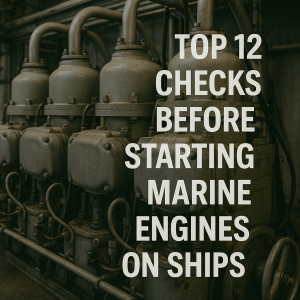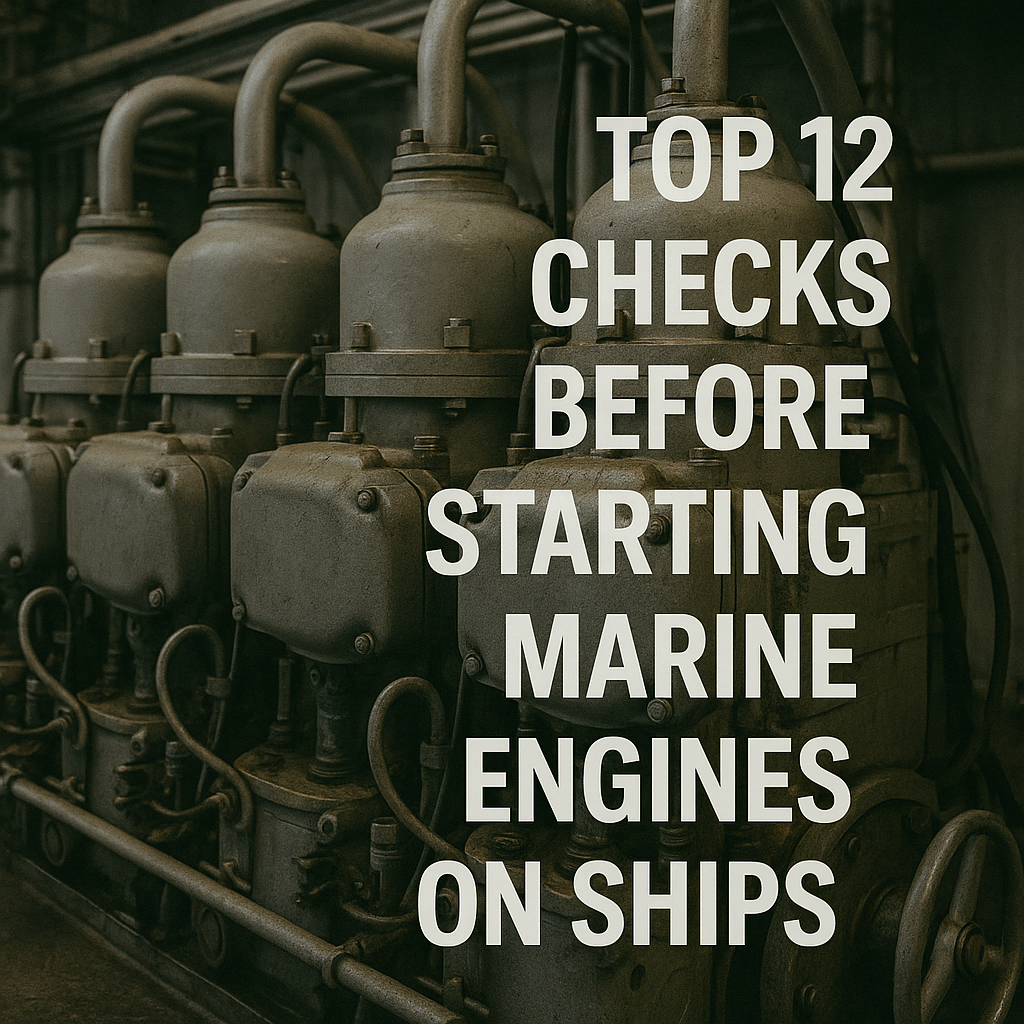Discover the 12 essential checks before starting a marine engine on board ships. Learn how these practices boost safety, reliability, and compliance in modern maritime operations.
Starting a ship’s marine engine might seem routine — you push the button, hear the powerful roar, and off you go. But behind that apparent simplicity lies a network of checks, routines, and safeguards built on decades of maritime engineering wisdom and regulatory standards. Whether on a modern container vessel, a chemical tanker, or a passenger ship, failing to perform these critical checks can have serious consequences, including pollution, breakdowns, and even catastrophic loss of life.
For seafarers, engineers, maritime cadets, and port authorities, understanding these checks is not just about ticking boxes. It is about respecting a tradition of safety that protects lives, preserves valuable assets, and ensures compliance with international conventions like SOLAS, MARPOL, and ISM.

Why These Checks Matter in Modern Maritime Operations
Marine engines are not simple machines. They are precision-engineered systems involving fuel, air, cooling, lubricating oil, automation, and monitoring — often running continuously for weeks or months. Neglecting pre-start checks is a major contributor to shipboard incidents. According to the UK’s Marine Accident Investigation Branch (MAIB), nearly 18% of engine-related incidents in 2022 were traced back to improper or skipped pre-start checks (MAIB, 2023).
Furthermore, the International Association of Classification Societies (IACS) reminds operators that well-executed engine start procedures are part of a ship’s safety management system under the ISM Code (IACS, 2023). In a world of growing decarbonization, a faulty startup can also mean avoidable fuel waste and emissions, conflicting with the IMO’s GHG reduction targets (IMO, 2023). Simply put, starting a marine engine correctly is a fundamental duty of any maritime professional.
The 12 Essential Checks Before Starting a Marine Engine
Let’s break these down with a seafarer’s eye — practical, no-nonsense, and rooted in experience.
1. Check Lubricating Oil Level and Condition
Marine engines, like the heart of any ship, cannot survive without good lubrication. Inadequate oil levels or contaminated oil can cause metal-to-metal contact, leading to catastrophic failure.
Picture this: an oiler skipping the dipstick check finds out later that a crankcase bearing has seized due to low oil. The repair bill? Often in the tens of thousands of dollars, plus downtime.
Action: Always verify oil levels against manufacturer specs, look for water contamination, and check oil filters.
2. Verify Cooling Water System
The engine’s cooling system prevents dangerous overheating. Poor cooling water circulation can cause engine components to warp or seize.
A marine engineer on a VLCC once neglected to open a sea chest valve after maintenance. Within minutes of startup, the high-temperature alarms screamed, and emergency shutdown was triggered. A costly, embarrassing lesson.
Action: Confirm sea suction valves are open, cooling pumps are working, and no obstructions exist in the pipeline.
3. Inspect Fuel System and Check for Leaks
Leaks in the fuel system can cause fires, which remain one of the top three causes of shipboard fatalities (Lloyd’s Register, 2023).
Before starting, check fuel pipes, injector lines, filters, and drains for leaks or damage. A fine mist of fuel oil under pressure can ignite in seconds if sprayed onto hot engine parts.
4. Test Starting Air System
Marine diesel engines often rely on compressed air to start. If the starting air receivers are empty, or if air compressors are faulty, the engine will simply refuse to turn over.
In worst cases, sudden air line failure during starting can injure nearby crew due to massive pressure release.
Action: Check air pressure in receivers, drain water from air bottles, and test the air starting valve for correct operation.
5. Check for Any Engaged Turning Gear
Never, ever start a marine engine with the turning gear engaged. It is a classic — and deadly — error.
Turning gears lock the crankshaft for maintenance or inspections. Starting with the gear still engaged can snap the turning gear shaft or even lead to crankcase explosions.
Action: Physically confirm the turning gear is disengaged and the indicator lamp is off.
6. Ensure Proper Fuel Oil Temperature
Marine engines running on heavy fuel oil require correct fuel temperature for atomization. If the fuel is too cold, it will clog injectors and damage the fuel pump.
Action: Check the heater temperatures for the fuel supply line and confirm temperatures are within manufacturer recommendations.
7. Inspect Cylinder Lubricators and Rocker Arms
Marine engine cylinders require regular lubrication, especially before a cold start. Dry cylinders will score or wear out quickly.
Action: Verify cylinder lubricators are primed and functioning, and inspect rocker arms for any loose connections or damage.
8. Check Jacket Water Temperature
Preheating the jacket water reduces thermal stress and ensures smooth engine startup. Starting an engine with ice-cold water inside risks sudden expansion of engine parts, leading to cracks or leaks.
Action: Confirm that the jacket water temperature is at the recommended pre-start level, usually around 60–70°C depending on engine design.
9. Inspect the Exhaust System
Blocked exhaust valves or faulty silencers can cause dangerous backpressure or even fires.
A chief engineer once told of an engine room fire caused by insulation material left inside the exhaust after repairs. Only a thorough visual check prevented worse damage.
Action: Check exhaust gas pathways, dampers, and spark arrestors before starting.
10. Verify Alarms and Safety Trips
The alarm and safety systems are the “watchdogs” of a modern marine engine. If they do not work, you are sailing blind.
Before startup, engineers should test alarms for lubricating oil pressure, cooling water temperature, overspeed trips, and crankcase mist detectors.
Action: Follow the ship’s PMS (Planned Maintenance System) checklist to verify alarms are operational.
11. Confirm Proper Engine Room Ventilation
Fumes, heat, or accidental fuel leaks can become deadly if trapped in an enclosed engine room.
A ventilation fan failure during startup could fill the space with dangerous gases in minutes.
Action: Ensure all fans and dampers are running and check emergency ventilation pathways are clear.
12. Conduct a Visual Walk-Around Check
Finally, never underestimate the value of a good engineer’s intuition. Walk around the entire engine space, listen, look, and feel. You might catch a missing nut, a leaking pipe, or a loose guard that no checklist would pick up.
As experienced maritime trainers say, “One minute walking around can save a million dollars later.”
Real-World Applications and Case Studies
Case histories are powerful teachers.
In 2021, a ro-ro vessel suffered a main engine failure while departing a European port. Investigators found the fuel heater had not been preheated correctly, leading to cold, waxy fuel that starved the injectors. The ship had to drop anchor, causing port congestion and costing the company tens of thousands of euros in delay fees (EMSA, 2022).
Similarly, the MAIB has repeatedly cited neglect of turning gear disengagement as a root cause of serious mechanical damage on board. These stories are cautionary — but they also underline how thorough pre-start checks protect both people and profit.
Challenges and Solutions in Ship Engine Start Checks
Challenges
-
Time pressure in busy ports
-
Inexperienced or fatigued crew
-
Missing or outdated checklists
-
Inadequate training
Solutions
-
Enforce a strong safety culture on board
-
Regular drills and crew familiarisation
-
Use PMS systems (Planned Maintenance Systems) with clear digital checklists
-
Participate in courses run by maritime academies or societies like IMarEST
It is worth remembering that SOLAS Regulation II-1/26 specifically requires that all essential machinery must be maintained in “effective working order” (IMO SOLAS, 2020).
Future Outlook
With decarbonization goals advancing, marine engine systems are evolving. LNG-fuelled and hybrid propulsion systems are becoming more common. This means pre-start checks will expand to include:
-
LNG leak detection
-
Battery charge status (in hybrid systems)
-
Digital alarm integrations
-
Remote monitoring from shore
The fundamentals, however, will remain unchanged: a marine engine is only as good as the people who prepare it.
FAQ
Why are pre-start checks important for marine engines?
They prevent breakdowns, fires, pollution, and costly delays — protecting crew safety and company assets.
How often should I do these checks?
Before every engine start after lay-up, major maintenance, or port stays.
Can I automate these checks?
Digital PMS systems can help, but a human’s senses and judgement remain irreplaceable.
What if I’m unsure about a step?
Never guess — always refer to the ship’s technical manual or seek the chief engineer’s guidance.
Are these checks legally required?
Yes, indirectly. ISM Code, SOLAS, and class rules all require good operating practices, including thorough pre-start inspections.
Conclusion
At sea, the smallest error can snowball into a maritime disaster. Yet by respecting these 12 time-tested checks before starting your marine engine, you protect your crew, your vessel, and the marine environment.
Think of these checks as part of a seafarer’s honour code — a promise to uphold the safety of the ship, her cargo, and her people.
The next time you reach for that start button, pause. Run through these checks like a captain plotting a safe course through a storm. Your ship — and your own peace of mind — will thank you.
References
-
MAIB. (2023). Marine Engine Casualty Reports. https://www.gov.uk/government/organisations/marine-accident-investigation-branch
-
IMO. (2023). GHG Reduction Strategy. https://www.imo.org
-
IACS. (2023). Engine Room Best Practices. https://www.iacs.org.uk
-
EMSA. (2022). Ship Incident Reports. https://www.emsa.europa.eu
-
Lloyd’s Register. (2023). Marine Safety Trends. https://www.lr.org


One thought on “Top 12 Checks Before Starting Marine Engines on Ships”